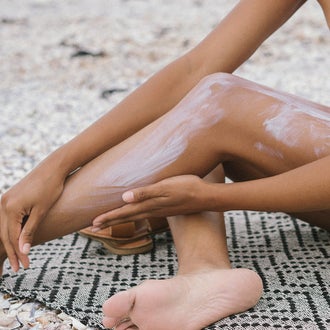Recipes for homemade sunscreens are easily found and promoted online, often by individuals without any specific health expertise. These recipes frequently contain coconut or vegetable oils, essential oils, shea butter, beeswax and zinc. Cancer Council does not recommend making or using homemade sunscreen. Instead, leave sunscreen manufacture to the experts so you know that what you’re using is safe and effective. In Australia the sale of sunscreen is regulated by the Australian Federal Government’s Therapeutic Goods Administration (TGA) ensuring that only approved ingredients, which have been assessed for quality and safety, are used in each product and at certain quantities.
Sunscreens are also given a Sun Protection Factor (SPF) rating to indicate the level of protection they provide from the sun’s harmful UV radiation. Once a sunscreen has passed these tests it is given an AUST L number and listed on the Australian Register of Therapeutic Goods.
Homemade sunscreen is not subject to any of this testing, despite some websites claiming an SPF rating for their recipe. While the ingredients might be natural, most have not been tested for their ability to absorb or reflect cancer-causing UV radiation or protect against sunburn. Natural oils generally have a very low UV radiation blocking ability, insufficient to provide any sun protection.
Some homemade sunscreen recipes include zinc oxide and titanium dioxide, ingredients which do provide sun protection. However, for these ingredients to provide any level of protection they must be included at the correct concentration and evenly distributed throughout the sunscreen. This is unlikely to be achieved in the home. All sunscreens sold in Australia are manufactured under the principles of Good Manufacturing Practice, ensuring the stability and reliability of the product. Therefore, Cancer Council does not recommend using homemade sunscreen.
Australia has one of the highest rates of skin cancer in the world with almost 2000 deaths annually. The majority of these skin cancers are caused by over exposure to the sun’s UV radiation. Most skin cancer can be prevented by using a combination of sun protection measures including TGA-approved sunscreen. However, it’s important to remember sunscreen isn’t a suit of armour and should only be used as the last line of defence. Cancer Council recommends following these five SunSmart steps whenever UV levels reach three or above:
- Slip on some sun-protective clothing that covers as much skin as possible.
- Slop on SPF50 or SPF50+ broad spectrum, water resistant sunscreen. Apply the recommended amount 20 minutes before you go outdoors. Reapply every two hours or after swimming sweating or towel drying.
- Slap on a broad-brim hat that shades the face, neck and ears.
- Seek shade.
- Slide on some sunglasses – make sure they meet Australian Standards.

